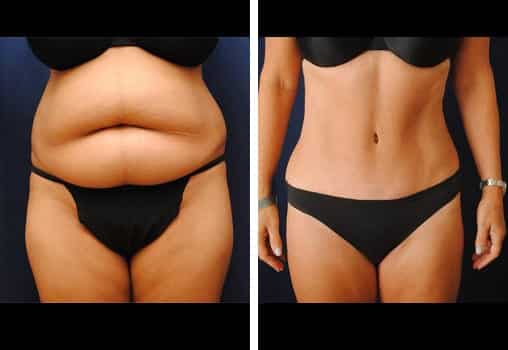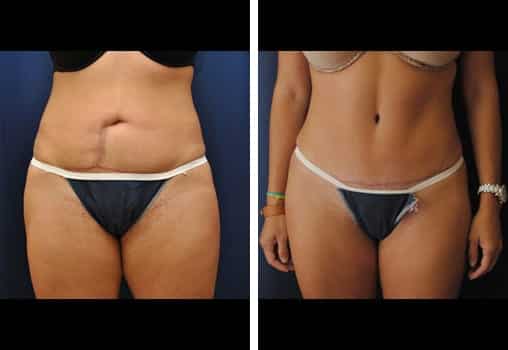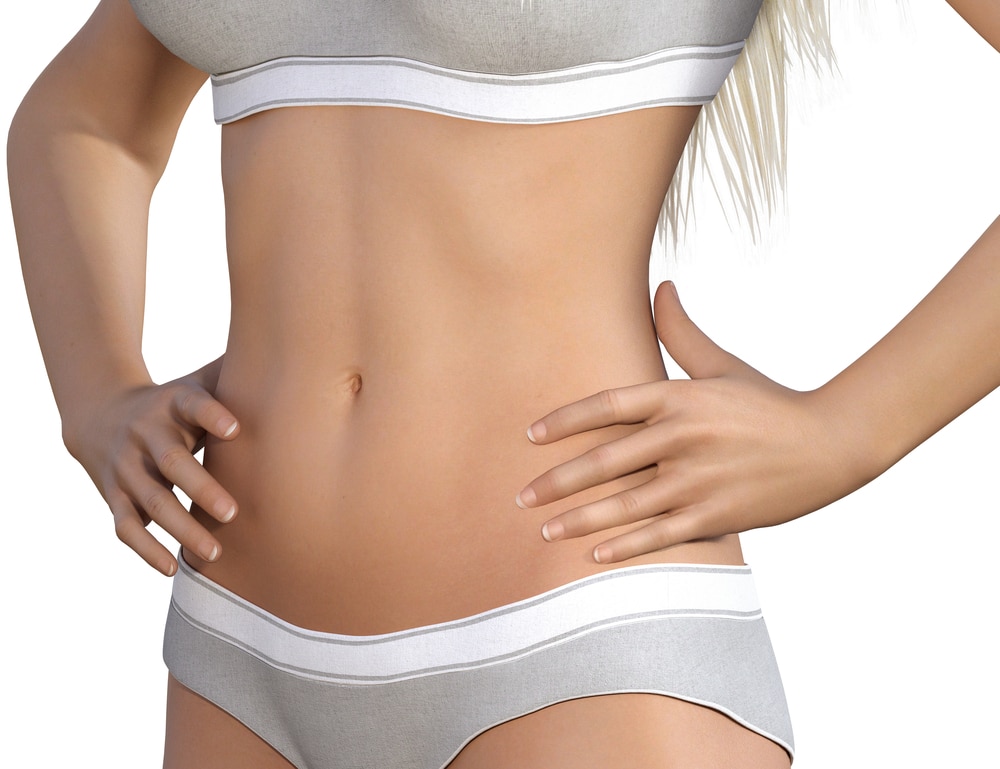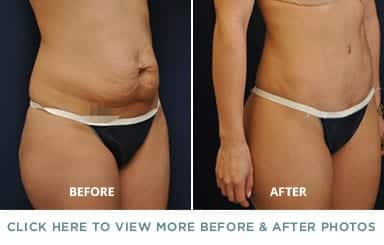Tummy Tuck Results - Before And After Photos


What Is A Tummy Tuck?
Clinically known as abdominoplasty, the goal of a tummy tuck is to tighten and change the contour of the abdomen area. The procedure removes excess fat and skin, and repositions weakened or separated muscles, resulting in a flatter, more contoured abdomen. Tummy tucks can have different lengths of incisions. Dr. Paul A. Watterson completely adapts the methods used for each of his tummy tuck procedures to the patient.

What Are The Different Kinds Of Tummy Tucks?
As mentioned above, Dr. Watterson uses different methods for his tummy tuck procedures based on the individual patient.
Standard Abdominoplasty
Also known as a full tummy tuck, Dr. Watterson makes two incisions. The first incision runs from hipbone to hipbone, usually running along the pubic hairline. The goal is to be able to cover the scar with a bathing suit. The second incision is made at the belly button. Once the skin is separated from the underlying muscle, the abdominal muscles are pulled together and stitched into place to make the abdomen firmer and to narrow the waist. This repairs stomach muscles that have actually become separated. Next, the skin is pulled downward, excess skin is trimmed away, and the navel reattached in a natural position.
These full tummy tucks are usually the best option for women who have had children, as the localized weight gain stretches the stomach skin and separates the support muscles.
Lipoabdominoplasty Or Saldanha Technique
This is a newer technique which uses liposuction to thin the central abdominal tissues as well as tighten the skin of the abdomen. It was developed and promoted by Osvaldo Saldanha from Brazil. Dr. Watterson has used this method now for several years and the results are remarkable. Many patients want additional fat removed from the central abdomen as well as tightening loose skin and muscles.
Umbilical (Belly Button) Float Or Transposition
This technique is ideal for patients who still want to preserve a very natural belly button, and who have a small amount of loose skin or significant abdominal muscle diastasis or spread. In the right candidate, it is a wonderful procedure with very satisfying outcomes.
Partial Abdominoplasty (Mini Tummy Tuck)
Also known as a mini tummy tuck, in this procedure Dr. Watterson makes just a single incision along the pubic line. The length of this incision may vary depending on the degree of the patient’s sagging. Mini tummy tucks can be good for patients who don’t have a lot of excess sagging skin, but simply want to remove their stomach pooch.
Circumferential Abdominoplasty (Extended Tummy Tuck)
This method involves the same incisions as with a standard tummy tuck, but the bottom incision is extended. Where it usually stops at the hipbone in a standard procedure, here it extends around the flanks and onto the back. This allows Dr. Watterson to also address sagging, excess skin and fat on the outer thighs and buttocks. Fat and skin that are hanging over the belt line will be removed to create a slimmer, smoother contour. Dr. Watterson will tighten applicable muscle and will likely use some liposuction to remove unwanted pockets of fat.
This method involves the same incisions as with a standard tummy tuck, but the bottom incision is extended. Where it usually stops at the hipbone in a standard procedure, here it extends around the flanks and onto the back. This allows Dr. Watterson to also address sagging, excess skin and fat on the outer thighs and buttocks. Fat and skin that are hanging over the belt line will be removed to create a slimmer, smoother contour. Dr. Watterson will tighten applicable muscle and will likely use some liposuction to remove unwanted pockets of fat.
Am I A Good Candidate For A Tummy Tuck?

Tummy tucks are great procedures for the right candidates! Usually, but not always tummy tucks are for patients who have lost significant weight and the skin is loose and “floppy”. Tummy tucks are for patients who have skin laxity for whatever reason such as weight loss, pregnancy and resulting stretch marks, or for those patients where the abdominal (rectus abdominus) muscles have spread apart. This can be defeating for a patient who works hard to control weight and exercise only to find a bulging abdomen in the midline.
It is generally suggested that this procedure be done after a woman completed child bearing. There are exceptions of course, and massive weight loss and other considerations are explored at the consult.
Tummy tucks have become much more refined with the introduction of “Exparel” a long acting numbing medication and progressive tension sutures which provide subtle but beautiful midline groove on the tummy. These improvements along with the Saldanha lipoabdominoplasty have made for incredible advances in this very popular and sought-after procedure.
Safety is always paramount, and patients who are overweight increase the risk of surgery. Smokers, obese patients and those who are prone for blood clotting must be carefully screened and counseled before surgery.
There are many different types of tummy tucks including a circumferential or extended type. Standard tummy tucks are most common but are being replaced by a newer and improved technique popularized by Brazilian surgeon Osvaldo Saldanha. This is a combined liposuction and tummy tuck procedure that is truly remarkable. Other kinds are mini and skin- only tummy tucks and a technique called an umbilical float or belly button floating technique for more minor type skin issues.
All of these should match the concern of the patients and be guided by an experienced and skillful surgeon familiar with these techniques. There is no substitution for a well trained plastic surgeon who has years of experience and judgement. Do your homework and seek out a surgeon with top credentials, and experience and who loves his work.
The best way to determine whether or not you are a good candidate for a tummy tuck is to meet with Dr. Watterson, who has many years of excellent surgical experience and can suggest the most appropriate procedure for you. He will hear your concerns and then offer a plan that is best for you and your particular situation. He can show you different results and guide you to an excellent outcome.
New Advances In Abdominoplasty
As with all cosmetic surgeries, new methods and tools are constantly being explored and implemented. For abdominoplasty, there are two improvements that our patients really love. One is an extended anesthetic called Exparel®. The other is Drain-Free Recovery.
Exparel - Extended Anesthetic
Exparel® is a non-opiod, non-narcotic anesthetic that is designed to release into your body over a long period of time for lasting pain relief immediately following your tummy tuck surgery. Exparel® contains specially formulated bupivacaine (a type of local anesthetic). During your surgery, Dr. Watterson injects Exparel® into the surgical area. It then slowly releases the bupivacaine for up to about 72 hours (3 days). In a tummy tuck this amount of time gets patients through the most uncomfortable portion of their recovery.
Research has shown that patients who are given Exparel® use two thirds less pain medication than those who have typical anesthesia and recovery. Patients with Exparel® are able to get back to their normal routines more quickly and they feel better through their recovery.
Progressive Tension Sutures & Drains
The placement of drains has been a part of abdominoplasty since the beginning. Their job has been to stop the buildup of fluids between the abdominal wall and the newly lift tissue. But drains are messy. They can clog. Hoses can crimp. And patients don’t like them because they are so inconvenient.
But drains may now be necessary only for a short time thanks to the invention of progressive tension sutures. Dr. Watterson uses a quilting technique that secures the abdominal skin to the underlying tissue layers, creating a tighter bond and leaving little or no room for fluid to build up. This shortens the time needed for drains.
A second benefit of progressive tension sutures is that Dr. Watterson can make the long tummy tuck incision much lower, making it far easier to conceal. These sutures also reduce tension on the incision, which makes the ensuing scar less visible.
Can I Combine My Tummy Tuck with Other Procedures?
Yes, you can have abdominoplasty at the same time you also have other procedures. Dr. Watterson will design your surgical plan around your desired outcome and as it's safest for you based on your current health and the number of areas you would like to improve. Some of the most common combinations include abdominoplasty and breast surgery. This may be breast augmentation, a breast lift, or even breast reduction.
Will Abdominoplasty Give Me a Six-Pack?
Many people who seek abdominoplasty do so with the expectation of having sculpted abs. This expectation isn't always expressed, so it's important to reflect on it before you schedule your surgical consultation. In our office, this reflection can have a significant impact on the tummy tuck technique that's recommended for you. In general, though abdominoplasty tightens the abdominal muscle, it does not reveal a sculpted six-pack unless your abs are already carved through your exercise habits. That said, we mentioned that it's beneficial to know your desire for sculpted abs when we first meet you because Dr. Watterson is one of the few plastic surgeons in our region who performs the Saldanha lipoabdominoplasty technique. This combination of precise liposuction and abdominoplasty is designed to thin out fatty tissue and tighten the muscle in a unique pattern (some released, some left attached), thereby increasing the chances of a more sculpted appearance. If you want a six-pack, be sure to let the doctor know when you visit!
Will I have a Large Scar from My Tummy Tuck?
Your tummy tuck procedure will produce a scar. The length of your incisions will depend somewhat on the type of tummy tuck you choose to have. In any case, Dr. Watterson is careful to place incisions as low on the abdomen as possible. Usually, the scar that results from abdominoplasty sits below the bikini line. At first, the scar may look red and raised. Over the course of the year following your tummy tuck, you can expect your scar to gradually become lighter and flatter. At some point during your recovery, you may turn your attention to scar treatment to promote optimal tissue recovery.
Can I Get Pregnant After a Tummy Tuck? What Happens If I Do?
Having a tummy tuck does not impact your ability to become pregnant. It's important to continue using your chosen birth control method after your surgery. If you were to get pregnant, you won't face any greater risk to your pregnancy than you would normally. The primary concern about getting pregnant after abdominoplasty is the way that your body will change. Fluctuations in your weight and the stretching of the abdominal wall can degrade the effects achieved through your tummy tuck, leaving you with loose, saggy skin once again. These effects can be reversed with a second tummy tuck.
Can I Get a Tummy Tuck If I Plan to Have More Children?
You certainly can, but it’s best to wait until you’re finished having children before undergoing a tummy tuck. Pregnancy can stretch your abdominal skin and muscles again, which may compromise your surgical results and create the need for a revision procedure. While the surgery doesn’t affect your ability to become pregnant or carry a healthy pregnancy, most patients choose to wait in order to maintain their new contour long term. If you do become pregnant unexpectedly after surgery, Dr. Watterson can discuss options to restore your shape afterward.
Is a Tummy Tuck Painful?
Some discomfort is expected following a tummy tuck, particularly due to the muscle repair involved in the procedure. However, Dr. Watterson uses Exparel®, a long-acting local anesthetic injected into the surgical area, which provides targeted pain relief for up to 72 hours. Many patients are surprised at how manageable their discomfort is with this technique and oral medication.
Can a Tummy Tuck Help with Back Pain or Posture?
In some cases, yes. Many patients with weakened or separated abdominal muscles (diastasis recti) experience poor core stability, which can contribute to back pain and poor posture. By tightening these muscles, a tummy tuck can improve core support and help realign posture. This often leads to better spinal alignment and reduced pressure on the lower back, especially when combined with regular exercise and physical therapy.
How Soon Can I Return to Work after a Tummy Tuck?
Most patients return to desk jobs or non-strenuous work within a couple weeks. If your job involves physical labor, heavy lifting, or extended periods on your feet, you may need additional time off. It’s important to follow Dr. Watterson’s recommendations for activity restrictions to ensure proper healing and avoid complications.
Can I Sleep on My Stomach after a Tummy Tuck?
It’s important to avoid stomach-sleeping for several weeks after surgery to protect your incision and avoid straining the repaired abdominal muscles. The ideal sleeping position is on your back with your head and upper body slightly elevated and your knees supported by a pillow to reduce tension in your midsection. This helps improve comfort and healing in the early stages of recovery.
What Should I Eat to Speed Up Tummy Tuck Recovery?
A nutritious, well-balanced diet plays a key role in healing. Focus on lean protein (chicken, fish, legumes), colorful vegetables, fresh fruits, whole grains, and healthy fats. These foods provide essential vitamins, antioxidants, and amino acids that promote tissue regeneration and reduce inflammation. Staying well-hydrated also helps flush toxins and supports circulation. Try to avoid alcohol, processed foods, and excess sugar or sodium, as they may increase swelling and delay recovery.
Will a Tummy Tuck Help Me Lose Weight?
A tummy tuck is not a weight loss procedure. It’s designed to contour your abdomen by removing excess skin and repairing stretched or separated muscles. While you may lose a small amount of weight from the removal of skin and fat, the primary benefit is improved shape and firmness, not a lower number on the scale. However, many patients feel more motivated to maintain a healthy lifestyle after surgery, which can support long-term weight stability.
How Long Does It Take To Recover From A Tummy Tuck?
Tummy tucks or abdominoplasties are very much like going through a C-section. Many women can relate to that. It takes about six weeks to get back to a routine exercise regimen and one must be careful particularly in the first two weeks to be careful with activity levels to avoid postoperative bleeding.

One remarkable medical breakthrough has been the introduction of Exparel, a long acting type of “Novocain” that can decrease pain significantly by providing anesthetic relief for approximately 3 days. Dr. Watterson has been using this for several years now and it has been a game-changer for tummy tucks. Patients can move more freely and tolerate the muscle repair much more easily, almost that we must remind patients to curb their activity levels early on.
Most patients can shower the next day. Patients are encouraged to walk about the house initially and then increase that activity. Patients can drive once off pain meds and ibuprofen is introduced early on to get patients off the narcotics which may cause constipation and feelings of nausea.
What Are The Risks Involved With A Tummy Tuck?
Abdominoplasty is major surgery, and the procedure involves the same risks as with most any surgery: reaction to anesthesia, poor healing, continued bleeding, and danger of infection. The procedure with Dr. Watterson involves very low rates of complication or risk. However, it’s important to remember there will be a major scar involved. Dr. Watterson places the incision at a height that can be hidden under panties or a bikini bottom. Over time, the scar will fade. There can be some changes in skin sensation affecting the sensory nerves in the abdominal area. This usually resolves in the months after your procedure. There is also a risk of the incision healing unevenly, but this is very rare, especially with the new progressive tension sutures that place far less stress on the incision.
What’s The Difference Between A Tummy Tuck And Liposuction?
The procedures are completely different in execution, and they really have different goals. Liposuction uses a small cannula with suction to remove stubborn pockets of fat that don’t respond to dietary changes or exercise. The cannulas are inserted through very small incisions and then break up and suction out the unwanted fat. The incisions made to gain access are tiny, usually needing only a bandage to close them. There is little recovery. But liposuction is only a good procedure for patients who still have good elasticity in their stomach skin. That’s because their skin needs to tighten down over their slimmer contour when the underlying fat is removed. If the skin is inelastic, the skin will be loose where the fat was removed.
Tummy tucks are meant to remove excess sagging skin. They also seek to bring separated stomach muscles back together in the center of the stomach where they are anchored with sutures. Most tummy tucks also use at least a small amount of liposuction to remove small pockets of unwanted fat, but the main goal is the removal of sagging, loose skin. Tummy tucks require a fairly involved recovery due to the incision and the repositioning of muscles.
Brilliant Distinctions Rewards Program
Enrolling in this program is free, so if you are a skin care advocate why not take an easy step towards keeping your skin that much more healthy and radiant?
Patient Testimonials

"From the time you walk in until your last follow up visit he makes you a priority, never rushes, and makes sure you’re pleased with your results. I absolutely love my results and how he and the staff took care of me through it all."
–Dana C.
"I had a great experience with Dr Watterson. From the consultation, Pre-op to actual procedure. He had me fully prepared and informed. I came out of my surgery without any complications and had a normal recovery. I am very happy with my transformation. Would highly recommend Dr Watterson to anyone. His professionalism and work ethic is impeccable."
–Nira M.
"Dr. Watterson and his staff did a great job at taking care of me during and after my surgery. I would recommend him to anyone looking for top notch care and satisfaction."
–Kayla W.
Schedule Your Consultation Today!
Interested in learning more about Abdominoplasties? Call 801-571-2020 to schedule a consultation with Dr. Paul Watterson. Our practice serves Draper, UT and the greater Salt Lake City, Utah area.



